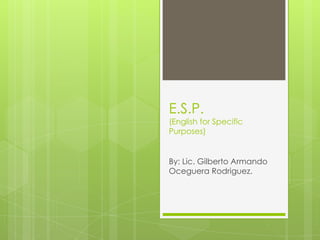
Esp unit 1
- 1. E.S.P. (English for Specific Purposes) By: Lic. Gilberto Armando Oceguera Rodriguez.
- 2. ABBREVIATION STUDENTS MUST KNOW…… EBE: English for Business and Economics. EFB: English for Business (LCCIEB). EFC: English for Commerce (LCCIEB). EFL: English as a Foreign Language.
- 3. ELT: English Language Teaching. EOP: English for Occupational Purposes. ESOL: English for Speakers of Other Languages ESS: English for Social Sciences. EST: English for Science and Technology.
- 4. EAP: English for Educational or Academic Purposes. GE: General English. EMP: English for Medical purposes. EVP: English for Vocational purposes. ESP: English for Specific Purposes.
- 5. E.S.P. (English for Specific Purposes) ORIGINS At the end of the Second World War in 1945. Enormous and extraordinary expansion in: Scientific Technical Economic activity The growth was world wide. The expansion created a more united world dominated by two forces: Technology and commerce
- 6. What was demanded by this new brave world? After the war ended. It started to happen The demand for an international language: ENGLISH
- 7. Why was English chosen? The notable power the USA had after the war. That’s why this role fell to English. English became the International Language of technology and commerce.
- 8. What was the effect when English was chosen? A new mass of people wanting to learn English. It was not just for the pleasure. Nor for the prestige of knowing the language. Because English was the key for : International Currencies of Technology and commerce. Previously the reasons for learning English had not been well defined.
- 9. Who were the people eager to learn English, now? Businessmen or women. Engineers Scientists Mechanics Doctors And of course Commerce. It created a new generation of learners, students wanted to learn more but books were written in English.
- 10. The reasons. why was this development accelerated? The oil crisis in the 1970s. “This resulted a massive flow of founds and westerns expertise into the oil-rich countries.”
- 11. What did these new demand create? Specific needs. Influential new ideas. The pursue of fulfillment in the study of English with new necessities.
- 12. What was the traditional and formal way of teaching linguistics? Describing Focus the usage of English. on the Grammar usage.
- 13. What was one of the findings of the new study research? That the language we speak and write varies considerably in many different ways from one context to another.
- 14. So, in the knowledge of the analysis, What did they notice about teaching English? That there are important differences between , say, of commerce that of engineering.
- 15. What was the main idea of creating ESP? If language varies from one situation of to another, it should be possible to determine the features of specific situations and then make these features the basis of the learners course
- 16. When did we really see the expansion of ESP, into the nature of particular varieties of English? In the late 1960s and the early 1970s.
- 17. Between the times WE JUST mention, In what area was the ESP most base on? Most of the work at this time was in the area of English for science and technology(EST). And for a time ESP and EST were considered as almost Synonymous.
- 18. What was then notice about the learners of different specialties? Learners were seen to have different needs and interest which influence in learning proses. The motivation to learn was different.
- 19. What were the three important factors that were brought about in the growth of ESP? 1. The expansion of demand for English to suit particular needs. 2. The developments in the fields of linguistics. 3. Educational Psychology.
- 20. In what phase is ESP considered to be going through at this time? In the 1960s was submitted to three main phases. In the fourth and starting the fifth phase.
- 21. According to the register analysis in the 1960s and early 1970s, who was the work mainly made by? Peter Strevens (Halliday, McIntosh and Strevens,1964). Jack Ewer (Ewer and Latorre,1969). John Swales(1971).
- 22. What did Ewer and Hudges-Davies find out with some of the text books students used(1971)? The found out that the school text books neglected some of the language forms commonly found In Science texts. In conclusion was that the ESP course should therefore, give priority to these forms (Compound nouns, passives, conditionals, modal verbs)
- 23. Beyond analysis, What had ESP focused on? On sentence grammar.
- 24. Soon, the idea of teaching ESP shifted. In what direction? How sentences were combined in discourse analysis.
- 25. What did the typical teaching materials based on discourse approach taught students? To recognize textual patterns. Discourse markers (Mainly by means of text-diagramming exercises.
- 26. What is needs analysis? It is a process in which is first used: A) Target situation. B) A rigorous analysis of linguistic features of the situation.
- 27. What did John Munby brought us in Communicative Syllabus Design(1978)? The Munby model produces a detailed profile of learners’ needs in terms of: A) Communication Purposes. B) Communicative settings. C) The means of communication. D) Language skills. E) Functions. F) Structures, etc…
- 28. What is the main idea behind the skill-centered approach? Underlying all language use. Common reasoning. Interpreting processes. “Regardless of the surface forms, enable us to extract meaning from discourse”.
- 29. According to learning – centered approach, What is the concern of ESP? It is not with language use. The concern is on language learning.